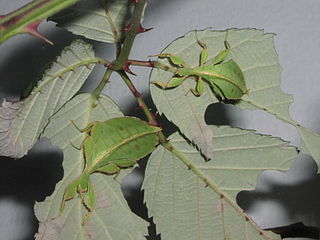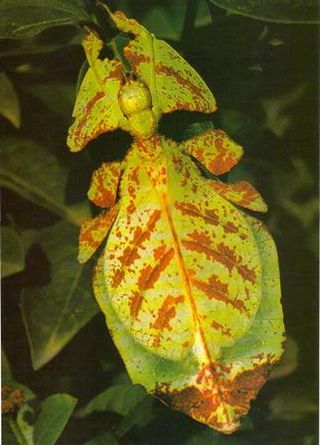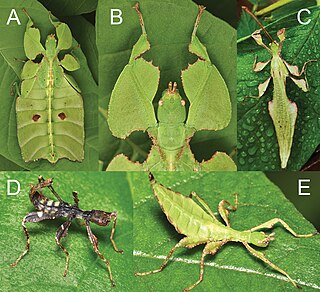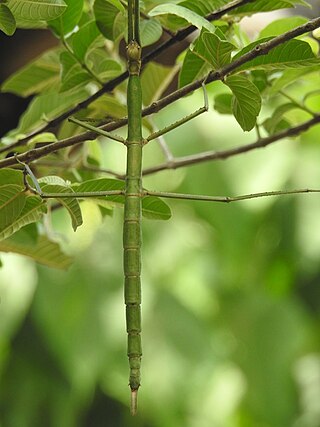
The Phasmatodea are an order of insects whose members are variously known as stick insects, stick-bugs, walkingsticks, stick animals, or bug sticks. They are also occasionally referred to as Devil's darning needles, although this name is shared by both dragonflies and crane flies. They can be generally referred to as phasmatodeans, phasmids, or ghost insects, with phasmids in the family Phylliidae called leaf insects, leaf-bugs, walking leaves, or bug leaves. The group's name is derived from the Ancient Greek φάσμα phasma, meaning an apparition or phantom, referring to their resemblance to vegetation while in fact being animals. Their natural camouflage makes them difficult for predators to detect; still, many species have one of several secondary lines of defense in the form of startle displays, spines or toxic secretions. Stick insects from the genera Phryganistria, Ctenomorpha, and Phobaeticus include the world's longest insects.

The eastern whipbird is an insectivorous passerine bird native to the east coast of Australia. Its whip-crack song is a familiar sound in forests of eastern Australia. Two subspecies are recognised. Heard much more often than seen, it is dark olive-green and black in colour with a distinctive white cheek patch and a crest. The male and female are similar in plumage.

The family Phylliidae contains the extant true leaf insects or walking leaves, which include some of the most remarkably camouflaged leaf mimics (mimesis) in the entire animal kingdom. They occur from South Asia through Southeast Asia to Australia. Earlier sources treat Phylliidae as a much larger taxon, containing genera in what are presently considered to be several different families.

Phyllium is the largest and most widespread genus of leaf insects in the family Phylliidae (Phasmatodea). They can be found in Sundaland, Philippine Islands, Wallacea, and Australasia.

Eurycnema goliath, commonly known as the goliath stick insect, or the regal stick insect, is a large species of stick insect in the family Phasmatidae, endemic to Australia and considered one of the largest species of stick insects in the country. The species has the Phasmid Study Group number PSG14.

Pulchriphyllium giganteum, commonly known as the Giant Malaysian Leaf insect, is a species of leaf insects described from Malaysia by Hausleithner in 1984 and placed in the genus Pulchriphyllium since 2021. Pulchriphyllium giganteum is the largest species belonging to the genus Pulchriphyllium reaching 105 mm in size. They are found most abundantly in the west Malaysian tropics. The females typically have large elytra that lie edge to edge on the abdomen and tend to lack hind wings making them usually flightless. Males have small elytra and sometimes transparent non-leaflike functional hind wings. Pulchriphyllium giganteum found in the wild tend to be mostly females and the first male of this species was not found until 1994. In captivity, the species has primarily been observed to reproduce through parthenogenesis meaning the females are asexual. The primary reproductive pattern in the wild is unknown. Eggs tend to be brown or black and glossy and resemble seeds. They hatch around 6 months after breeding. Newly hatched young nymphs tend to be wingless and brown or reddish in color. They develop their green color after feeding on leaves. Both the adult and larval stages are phytophagous meaning they feed on plants. The main plant food sources for this species are oak and bramble tree leaves.

Pulchriphyllium bioculatum, Seychelles leaf insect, Javanese leaf insect, or Gray's leaf insect, is a leaf insect of the family Phylliidae native to tropical Asia as well as Madagascar, Mauritius and the Seychelles. It was first described by George Robert Gray in 1832 and was the first phasmid he discovered. Leaf insects have extremely flattened, irregularly shaped bodies, wings, and legs. They are usually about 5–10 cm long. They are called leaf insects because their large, leathery forewings have veins that look similar to the veins on the particular type of leaves they inhabit. Its scientific name bioculatum means "two-eyed" and refers to the two dots located on the abdomen just in this species.

Cryptophyllium westwoodii is a species of leaf insect in the family Phylliidae. It is distributed from southern China, the Andaman islands, Myanmar, Indo-China, Sumatra and the Riouw Archipelago.

Phyllium bilobatum is a species of leaf insect in the family Phylliidae. It is found in the Philippines and Malaysia. This species was first described in 1843 by the English zoologist George Robert Gray, who gave it the name Phyllium bilobatum. It has been assigned to the subgenus Phyllium, which is to be distinguished from the second subgenus Pulchriphyllium, within the genus Phyllium. The holotype is a female from the Philippines, which is kept in the Natural History Museum, London where Gray worked cataloguing insects.

Phyllium letiranti is a species of phasmid or walking leaf of the genus Phyllium. It is only found on the island of Peleng in Indonesia.

Cryptophyllium is a genus of leaf insects in the tribe Phylliini, described in 2021. Its distribution is probably incomplete, but includes southern China, Sri Lanka, Indo-China, Malesia and western Pacific islands.

Symmorphus cristatus is a species of mason wasp in the subfamily Eumeninae within the family Vespidae. This species is widely distributed in North America, and it preys on the larvae of leaf beetles.

Pulchriphyllium is a genus of leaf insects. It was first established by Griffini in 1898 as a subgenus within the genus Phyllium and is a valid genus since 2021. The distinctive feature of Pulchriphyllium is the presence of lobes on the inside and outside of the fore tibia. In Phyllium are lobes only present on the outside. The representatives of the genus are native to both Sundaland and continental Asia.

Phyllium bonifacioi is a species of phasmatodea in the family Phylliidae.

Phyllium monteithi is a species of phasmatodea in the family Phylliidae. P. monteithi is found in tropical Queensland in Australia. The type specimen was collected from Mount Lewis, near Julatten. Reproduction occurs through parthenogenesis and conventional mating. P. monteithi is known to feed on leaves from the myrtle family however, another well known food plant is Szygium Australe. Males are between 61 and 64 mm in length, females to 76 mm. This species is popular as a pet in Australia and Europe.

Pulchriphyllium anangu is a species of leaf insect described in 2023. The species name is derived from a Yakshi in Tamil mythology.

Nanophyllium is a genus of leaf insects comprising 11 species, found in Australia, Papua New Guinea, Southern Indonesia, and the Indian Subcontinent. Not much is known about this genus, primarily due to their remote habitats and elusive appearance.

Walaphyllium is a genus of leaf insects comprising three species. It is found in Australia and Papua New Guinea. Walaphyllium monteithei is a popular pet, and is commonly bred throughout Europe and Australia.

Nesiophasma sobesonbaii is a species of stick insect.

Chitoniscus lobiventris, the lobed leaf insect, is an insect species classified within the order Phasmatodea and the family Phylliidae. Initially documented by Blanchard in 1853, its distinguishing feature lies in its leaf-like appearance, a characteristic adaptation for camouflage within its natural habitat. Like many Chitoniscus species, it is found in the South Pacific. The holotype specimen for this species was a male from Viti, Lebouka collected by Émile Blanchard. In August 1903, a female specimen was collected in Carins by R.C.L Perkins. Males and females were also collected in the Kolombangra of the Solomon Islands in April and October by M.Bigger.






















